1868 Democratic National Convention
The 1868 Democratic National Convention was held at Tammany Hall in New York City between July 4, and July 9, 1868. The slogan for the 1868 Democratic National Convention was, "This is a White Man's Country, Let White Men Rule".[1] The convention was notable for the return of Democratic Party politicians from the southern states.
| 1868 presidential election | |
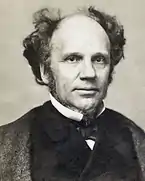 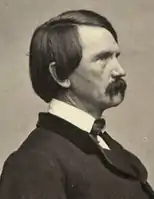 Nominees Seymour and Blair | |
| City | New York, New York |
|---|---|
| Venue | Tammany Hall |
| Candidates | |
| Presidential nominee | Horatio Seymour of New York |
| Vice presidential nominee | Francis P. Blair, Jr. of Missouri |
| Results (president) | Seymour (NY): 317 (100%) |
| Results (vice president) | Blair (MO): 317 (100%) |
Presidential nomination
Presidential candidates
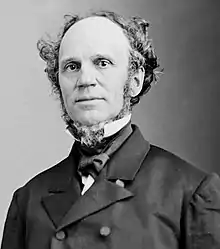
Former Governor
Horatio Seymour
of New York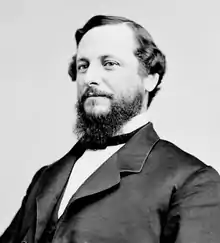
Former Representative George H. Pendleton
of Ohio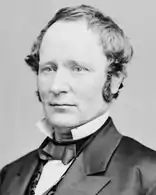
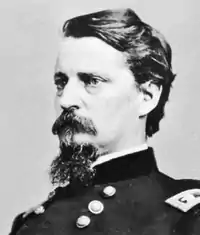
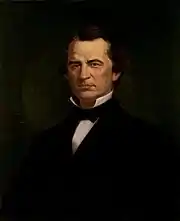
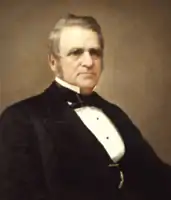
Former Lt. Governor
Sanford E. Church
of New York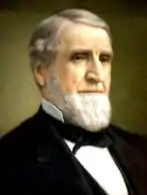
Former Representative Asa Packer
of Pennsylvania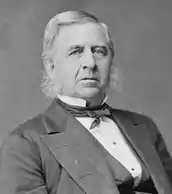
Governor
James E. English
of Connecticut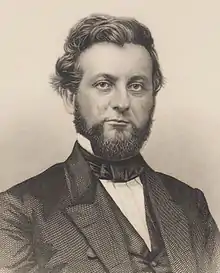
Former Governor
Joel Parker
of New Jersey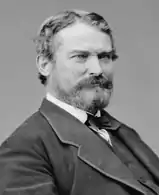
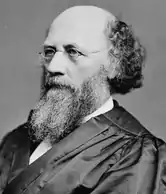
Associate Justice Stephen J. Field
of California
Former Representative Francis P. Blair
of Missouri.jpg.webp)
Chief Justice
Salmon P. Chase
of Ohio
(Not Nominated)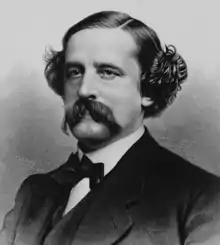
The front-runner in the early balloting was George H. Pendleton, who led on the first 15 ballots, followed in varying order by incumbent president Andrew Johnson, Winfield Scott Hancock, Sanford Church, Asa Packer, Joel Parker, James E. English, James Rood Doolittle, and Thomas A. Hendricks. The unpopular Johnson, having narrowly survived impeachment, won 65 votes on the first ballot, less than one-third of the total necessary for nomination, and thus lost his bid for election as president in his own right.
Meanwhile, the convention chairman Horatio Seymour, former governor of New York, received 9 votes on the fourth ballot from the state of North Carolina. This unexpected move caused "loud and enthusiastic cheering," but Seymour refused, saying,
I must not be nominated by this Convention, as I could not accept the nomination if tendered. My own inclination prompted me to decline at the outset; my honor compels me to do so now. It is impossible, consistently with my position, to allow my name to be mentioned in this Convention against my protest. The clerk will proceed with the call.[2]
After numerous indecisive ballots, the names of John T. Hoffman, Francis P. Blair, and Stephen Johnson Field were placed in nomination. This raised the number of names placed into nomination to thirteen. None of these new candidates, however, gained much traction.

For twenty-one ballots, the opposing candidates battled it out: the East battling the West for control, the conservatives battling the radicals. The two leading candidates were determined that the other should not receive the nomination; because of the two-thirds rule of the convention, a compromise candidate was needed. Seymour still hoped it would be Chief Justice Salmon P. Chase, but on the twenty-second ballot, the chairman of the Ohio delegation announced, "at the unanimous request and demand of the delegation I place Horatio Seymour in nomination with twenty-one votes-against his inclination, but no longer against his honor."
Seymour had to wait for the rousing cheers to die down before he could address the delegates and decline.
I have no terms in which to tell of my regret that my name has been brought before this convention. God knows that my life and all that I value most in life I would give for the good of my country, which I believe to be identified with that of the Democratic party...
"Take the nomination, then!" cried someone from the floor.
..but when I said that I could not be a candidate, I mean it! I could not receive the nomination without placing not only myself but the Democratic party in a false position. God bless you for your kindness to me, but your candidate I cannot be.[2][3]
Seymour left the platform to cool off and rest. No sooner had he left the hall than the Ohio chairman cried that his delegation would not accept Seymour's declination; Utah's chairman rose to say that Seymour was the man they had to have. While Seymour was waiting in the vestibule, the convention nominated him unanimously.
In 1868, the States of Arkansas, Alabama, Florida, North Carolina, South Carolina, Georgia, and Louisiana were readmitted to the Union. Nebraska had been admitted to the Union on March 1, 1867. Texas, Mississippi and Virginia had not yet been readmitted to the Union.
| Presidential Ballot | ||||||||||||
| 1st | 2nd | 3rd | 4th | 5th | 6th | 7th | 8th | 9th | 10th | 11th | 12th | |
|---|---|---|---|---|---|---|---|---|---|---|---|---|
| George H. Pendleton | 105 | 104 | 119.5 | 118.5 | 122 | 122.5 | 137.5 | 156.5 | 144 | 147.5 | 144.5 | 145.5 |
| Thomas A. Hendricks | 2.5 | 2 | 9.5 | 11.5 | 19.5 | 30 | 39.5 | 75 | 80.5 | 82.5 | 88 | 89 |
| Winfield Scott Hancock | 33.5 | 40.5 | 45.5 | 43.5 | 46 | 47 | 42.5 | 28 | 34.5 | 34 | 32.5 | 30 |
| Andrew Johnson | 65 | 52 | 34.5 | 32 | 24 | 21 | 12.5 | 6 | 5.5 | 6 | 5.5 | 4.5 |
| Sanford E. Church | 34 | 33 | 33 | 33 | 33 | 33 | 33 | 0 | 0 | 0 | 0 | 0 |
| Asa Packer | 26 | 26 | 26 | 26 | 27 | 27 | 26 | 26 | 26.5 | 27.5 | 26 | 26 |
| James E. English | 16 | 12.5 | 7.5 | 7.5 | 7 | 6 | 6 | 6 | 6 | 0 | 0 | 0 |
| Joel Parker | 13 | 15.5 | 13 | 13 | 13 | 13 | 7 | 7 | 7 | 7 | 7 | 7 |
| James R. Doolittle | 13 | 12.5 | 12 | 12 | 15 | 12 | 12 | 12 | 12 | 12 | 12.5 | 12.5 |
| Horatio Seymour | 0 | 0 | 0 | 9 | 0 | 0 | 0 | 0 | 0 | 0 | 0 | 0 |
| Francis Preston Blair | 0.5 | 10.5 | 4.5 | 2 | 9.5 | 5 | 0.5 | 0.5 | 0.5 | 0.5 | 0.5 | 0.5 |
| Reverdy Johnson | 8.5 | 8 | 11 | 8 | 0 | 0 | 0 | 0 | 0 | 0 | 0 | 0 |
| Salmon P. Chase | 0 | 0 | 0 | 0 | 0 | 0 | 0 | 0 | 0 | 0 | 0 | 0.5 |
| Thomas Ewing | 0 | 0.5 | 1 | 1 | 0 | 0 | 0 | 0 | 0 | 0 | 0 | 0 |
| John Q. Adams | 0 | 0 | 0 | 0 | 1 | 0 | 0 | 0 | 0 | 0 | 0 | 0 |
| George B. McClellan | 0 | 0 | 0 | 0 | 0 | 0 | 0 | 0 | 0 | 0 | 0 | 1 |
| Blank | 0 | 0 | 0 | 0 | 0 | 0.5 | 0.5 | 0 | 0.5 | 0 | 0.5 | 0.5 |
| Presidential Ballot | ||||||||||||
| 13th | 14th | 15th | 16th | 17th | 18th | 19th | 20th | 21st | 22nd Before Shifts | 22nd After Shifts | ||
|---|---|---|---|---|---|---|---|---|---|---|---|---|
| Horatio Seymour | 0 | 0 | 0 | 0 | 0 | 0 | 0 | 0 | 0 | 22 | 317 | |
| George H. Pendleton | 134.5 | 130 | 129.5 | 107.5 | 70.5 | 56.5 | 0 | 0 | 0 | 0 | 0 | |
| Thomas A. Hendricks | 81 | 84.5 | 82.5 | 70.5 | 80 | 87 | 107.5 | 121 | 132 | 145.5 | 0 | |
| Winfield Scott Hancock | 48.5 | 56 | 79.5 | 113.5 | 137.5 | 144.5 | 135.5 | 142.5 | 135.5 | 103.5 | 0 | |
| Andrew Johnson | 4.5 | 0 | 5.5 | 5.5 | 6 | 10 | 0 | 0 | 5 | 4 | 0 | |
| Asa Packer | 26 | 26 | 0 | 0 | 0 | 0 | 22 | 0 | 0 | 0 | 0 | |
| James E. English | 0 | 0 | 0 | 0 | 0 | 0 | 6 | 16 | 19 | 7 | 0 | |
| Joel Parker | 7 | 7 | 7 | 7 | 7 | 3.5 | 0 | 0 | 0 | 0 | 0 | |
| James R. Doolittle | 13 | 13 | 12 | 12 | 12 | 12 | 12 | 12 | 12 | 4 | 0 | |
| Stephen J. Field | 0 | 0 | 0 | 0 | 0 | 0 | 15 | 9 | 8 | 0 | 0 | |
| Francis Preston Blair | 0.5 | 0 | 0 | 0 | 0 | 0 | 13.5 | 13 | 0 | 0 | 0 | |
| Salmon P. Chase | 0.5 | 0 | 0 | 0 | 0.5 | 0.5 | 0.5 | 0 | 4 | 0 | 0 | |
| Thomas H. Seymour | 0 | 0 | 0 | 0 | 0 | 0 | 4 | 2 | 0 | 0 | 0 | |
| John T. Hoffman | 0 | 0 | 0 | 0 | 3 | 3 | 0 | 0 | 0.5 | 0 | 0 | |
| Thomas Ewing | 0 | 0 | 0 | 0 | 0 | 0 | 0 | 0 | 0 | 0 | 0 | |
| George B. McClellan | 0 | 0 | 0 | 0 | 0 | 0 | 0 | 0 | 0.5 | 0 | 0 | |
| Franklin Pierce | 1 | 0 | 0 | 0 | 0 | 0 | 0 | 0 | 0 | 0 | 0 | |
| Blank | 0.5 | 0.5 | 1 | 1 | 0.5 | 0 | 1 | 1.5 | 0.5 | 31 | 0 | |

1st Ballot
(Johnson's Peak)
8th Ballot
(Pendleton's Peak)
18th Ballot
(Hancock's Peak)
22nd Ballot
Before Shifts
(Hendricks' Peak)
22nd Ballot
After Shifts
(Seymour Nominated)
Vice Presidential nomination
Vice Presidential candidate

Former Representative Francis P. Blair
of Missouri
Withdrawn candidates
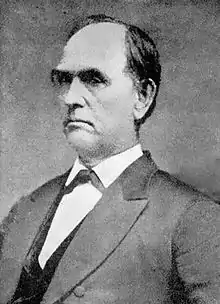
Former Senator Augustus C. Dodge
of Iowa
Declined
.jpg.webp)
Former Representative John A. McClernand
of Illinois
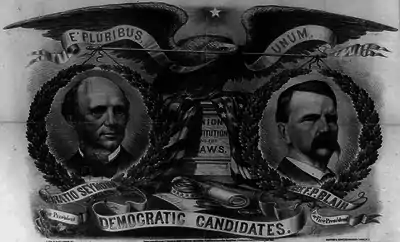
Exhausted, the delegates unanimously nominated General Francis Preston Blair, Jr. for vice-president on the first ballot after the names of Augustus C. Dodge and Thomas Ewing, Jr. were withdrawn from consideration. Blair's nomination reflected a desire to balance the ticket east and west as well as north and south.[4]
Blair had worked hard to acquire the Democratic nomination and accepted second place on the ticket, finding himself in controversy.[5] Blair had gained attention by an inflammatory letter addressed to Colonel James O. Broadhead, dated a few days before the convention met. In his letter, Blair wrote that the "real and only issue in this contest was the overthrow of Reconstruction, as the radical Republicans had forced it in the South."[6]
| Vice Presidential Ballot | 1st |
|---|---|
| Francis Preston Blair | 317 |

1st Vice-Presidential Ballot
See also
- History of the United States Democratic Party
- List of Democratic National Conventions
- U.S. presidential nomination convention
- 1868 Republican National Convention
- 1868 United States presidential election
References
- "The Worst Convention in U.S. History?". Politico Magazine. 22 July 2016. Retrieved 21 November 2019.
- They Also Ran, Irving Stone, pg. 280
- Official proceedings of the National Democratic convention, held at New York, July 4-9, 1868 (Pg. 153)
- Frank Blair: Lincoln's Conservative, William E. Parrish, pg. 254
- Frank Blair: Lincoln's Conservative, William E. Parrish, pg. 260
- Stewart Mitchell, Horatio Seymour of New York, Harvard University Press, 1938, p. 448
Bibliography
- Coleman, Charles Hubert. The election of 1868 : the Democratic effort to regain control (1933) online
Primary sources
- Chester, Edward W A guide to political platforms (1977) pp 86–89 online
- Official proceedings of the National Democratic convention, held at New York, July 4-9, 1868
External links
- Democratic Party Platform of 1868 at The American Presidency Project
| Preceded by 1864 Chicago, Illinois |
Democratic National Conventions | Succeeded by 1872 Baltimore, Maryland |